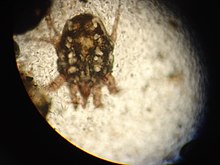Psoroptidia is a parvorder of the Acari (mite) group Astigma (or Astigmatina).[1] It comprises around 40 families, and apparently originated as parasites of birds, before a secondary radiation saw some taxa become parasites of mammals.[2] Because of their parasitic lifestyle, members of the Psoroptidia do not exhibit a deutonymph stage.[3]
| Psoroptidia | |
|---|---|

| |
| Psoroptes cuniculi (Sarcoptoidea: Psoroptidae) | |
| Scientific classification | |
| Domain: | Eukaryota |
| Kingdom: | Animalia |
| Phylum: | Arthropoda |
| Subphylum: | Chelicerata |
| Class: | Arachnida |
| Order: | Sarcoptiformes |
| Suborder: | Astigmata |
| Parvorder: | Psoroptidia Yunker, 1955 |
| Superfamilies | |
| |
The group contains many of the more notorious parasitic members of the Astigmata. Three of the superfamilies in this clade are among those Acarina collectively called feather mites, whereas the fourth and fifth – Psoroptoidea and Pyroglyphoidea – contains ear mites and scabies mites among others.
References
edit- ^ "Psoroptidae". NCBI taxonomy. Bethesda, MD: National Center for Biotechnology Information. Retrieved 31 May 2019.
- ^ Barry M. OConnor (1994). "Life-history modifications in astigmatid mites". In Marilyn A. Houck (ed.). Mites: Ecological and Evolutionary Analyses of Life-history Patterns. Springer. pp. 136–159. ISBN 978-0-412-02991-2.
- ^ Matthew J. Colloff (2009). "Identification and taxonomy, classification and phylogeny". Dust Mites. Springer. pp. 1–44. ISBN 978-90-481-2223-3.
Further reading
edit- Pavel B. Klimov & Barry M. OConnor (2008). "Origin and higher-level relationships of psoroptidian mites (Acari: Astigmata: Psoroptidia): Evidence from three nuclear genes". Molecular Phylogenetics and Evolution. 47 (3): 1135–1156. doi:10.1016/j.ympev.2007.12.025. PMID 18289886.